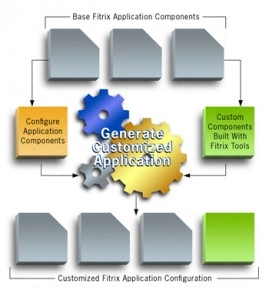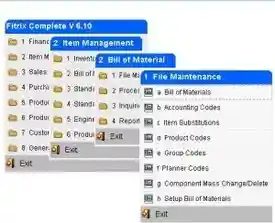Fitrix Pre-Install Requirements - Version 5.4x
Last Updated: April 2011
Server Minimums
- Processor: Pentium 4, Xeon or greater
- 32 or 64 bit
- Hard drive space: 12GB available for Fitrix on single hard drive
- RAM: 2GB (more is helpful, 4-8GB RAM recommended)
- Please note that additional licensing is required for servers with more than 2 dual core processors or 1 quad core processor. Additional licensing is also required if more than 4GB of RAM will be allocated to the IDS database (this is rarely a requirement).
Linux Distribution
Only the following Linux Distributions are supported:
Distribution Name | Distribution Version | Kernel | Glibc |
| RHES | 5.0-5.3 | 2.6 | 2.5 |
| RHES | 4 | 2.6 | 2.3 |
| SUSE | 10.0 | 2.6 | 2.3 |
| SUSE | 10.1 | 2.6 | 2.4 |
| SUSE | 10.2 | 2.6 | 2.5 |
| Debian | 5.0 | 2.6 | 2.7 |
| Debian | 4.0 | 2.6 | 2.3 |
| Ubuntu | 10.4 |
The following Linux Distributions are NOT supported:
- Red Hat Fedora
All other Linux Distributions must be approved by Fourth Generation Software to be supported
Linux Installation and Configuration Requirements
- Fitrix is only supported on native Linux operating systems which are installed and configured according to the manufacturer’s instructions. (Note: upgrading the kernel or glibc version on an existing Linux installation can create complications, and is not recommended).
- Fitrix is supported on a virtualized Linux operating system under VMWARE™, however Fitrix is not supported on Linux operating systems that are running through emulation or enhancement software or any other virtualization products.
- A Linux ‘C’ development system must be installed (‘GCC’ compiler + utilities + libraries). The GNU GCC compiler is strongly preferred.
- Install the package ''libstdc++.so.5'' (if not installed) The file ‘/usr/lib/libstdc++.so.5’ must exist (on some Linux distributions this requires a link when the file is located elsewhere).
- Install the package ''rpm'' (if not installed), and create the directory: ‘/var/lib/rpm’ if it does not exist.
- Install the package ''gawk'' (if not installed).
- The Linux firewall (ipchains service) must be turned off. (The Fitrix server cannot be a firewall server).
- The ‘termcap’ package (the termcap runtime libraries) must be installed. (This is done by default with most Linux distributions) The file ‘/usr/lib/libtermcap.so’ must exist (on some Linux distributions this requires a link when the file is located elsewhere)
- JAVA (jre) version 1.4.2 must be installed. (Fitrix Complete provides this, but if your server has an earlier version this will have to be upgraded).
- If the Fitrix Windows Thin Client will be used, install and enable one of the following: ssh (recommended), telnet, or rlogin.
- The Linux server must have a network card installed (even if not connected to a network).
- The Linux server must have a static I.P. address assigned (even if not connected to a network).
- The Linux server must be booted to level 3 (inetd must be running). If ‘X’ Clients will be used, the Linux server must be booted to level 5.
- Note that Fitrix Complete is a 32-bit product but will run on 64-bit systems. A 64-bit version of Fitrix is available at an additional cost.
- Server must have a CD/ROM drive
Partitioning your Linux drive space for Fitrix
There are many strategies for hard drives, RAID, and drive arrays and all are supported with Fitrix. Here are the minimum requirements and guidelines:
- All of Fitrix (the software and the database) installs under a single folder structure.
- For a typical installation, this is installed under /var/opt on the root (/) partition, however you are welcome to install it elsewhere.
- While a small Fitrix implementation will only need 8GB, today''s hard drives are far larger and we recommend allocating much more space to the root partition (or the Fitrix partition if not root).
- If you plan to use the Fitrix document clipboard feature (available soon) that allows importing documents and images into the Fitrix database, you will want to allocate much more space as 1GB will typically support 2000 to 8000 scanned document pages.
Linux partitions:
Swap - The standard recommendation is: 2X physical RAM for up to 2GB of physical RAM + 1X physical RAM for any amount above 2GB. i.e. for 2GB physical RAM, configure 4GB of Swap space, for 4GB of physical RAM, configure 6GB of Swap space.
/boot - this is not used by Fitrix and is typically set to a minimal size of around 128mb.
/tmp - this is optional but recommended as a separate partition rather than just a folder on the root partition. The /tmp partition should be mounted on /tmp. Fitrix uses /tmp for cache space for reports and temp database tables. This should be 5% to 10% of your total drive space, minimum 5GB.
/ (root) - For a typical installation with Fitrix installed under root, we recommending allocating your remaining space to the root partition.
There are other partitions that are commonly used all of which are optional and have no impact on Fitrix.
Connectivity Requirements For Fourth Generation Support
In order for Fourth Generation Software to provide any support assistance that requires access to your Fitrix ERP server or client, you will need to provide access using one of the following methods:
Linux Server (listed in order of preference)
- VPN – A VPN connection offers the highest level of connectivity allowing Fourth Generation to provide support more quickly and economically. Allows 24x7 access without user intervention. Windows VPN is preferred, FGSS will charge a fee for setting up connections to other VPN products.
- Remote Desktop onto a Windows Server – Allows 24x7 access without user intervention
- Remote Desktop onto a users workstation – The user cannot work while Fourth Generation is providing support.
- Webex access to a users workstation (or windows server) – Requires a user to allow access, the user cannot work while Fourth Generation is providing support.
- Any other method must be approved by FGSS, and FGSS will charge a fee for setting up the connection. (Please note that dial-up access is not supported)
Windows Client
If you are using the Fitrix ERP Windows Thin Client, your Windows PC must be connected to the internet and have a working web browser. Fourth Generation Software will use Webex to gain access to your Windows Client for Support.
Client Requirements
- Windows Client: (Minimum Requirements)
- Intel processor (486 and up)
- 10 MB available hard drive space
- 32 MB RAM
- TCP/IP and Telnet connection to Linux Host
- Windows 95 or better (Win 98/2000/ME/XP/NT/Vista/7)
- X11 (X-Windows) Client (Client must be Intel processor based and support WINE)


